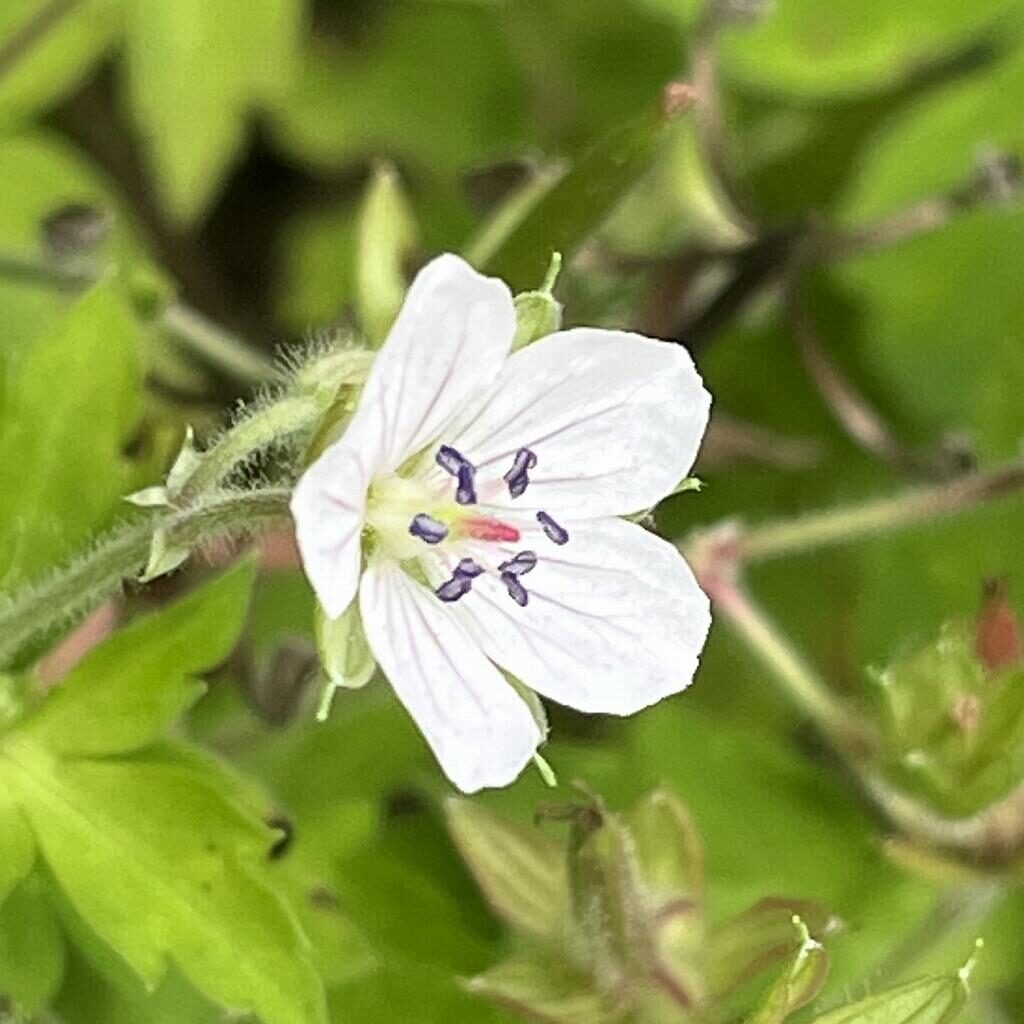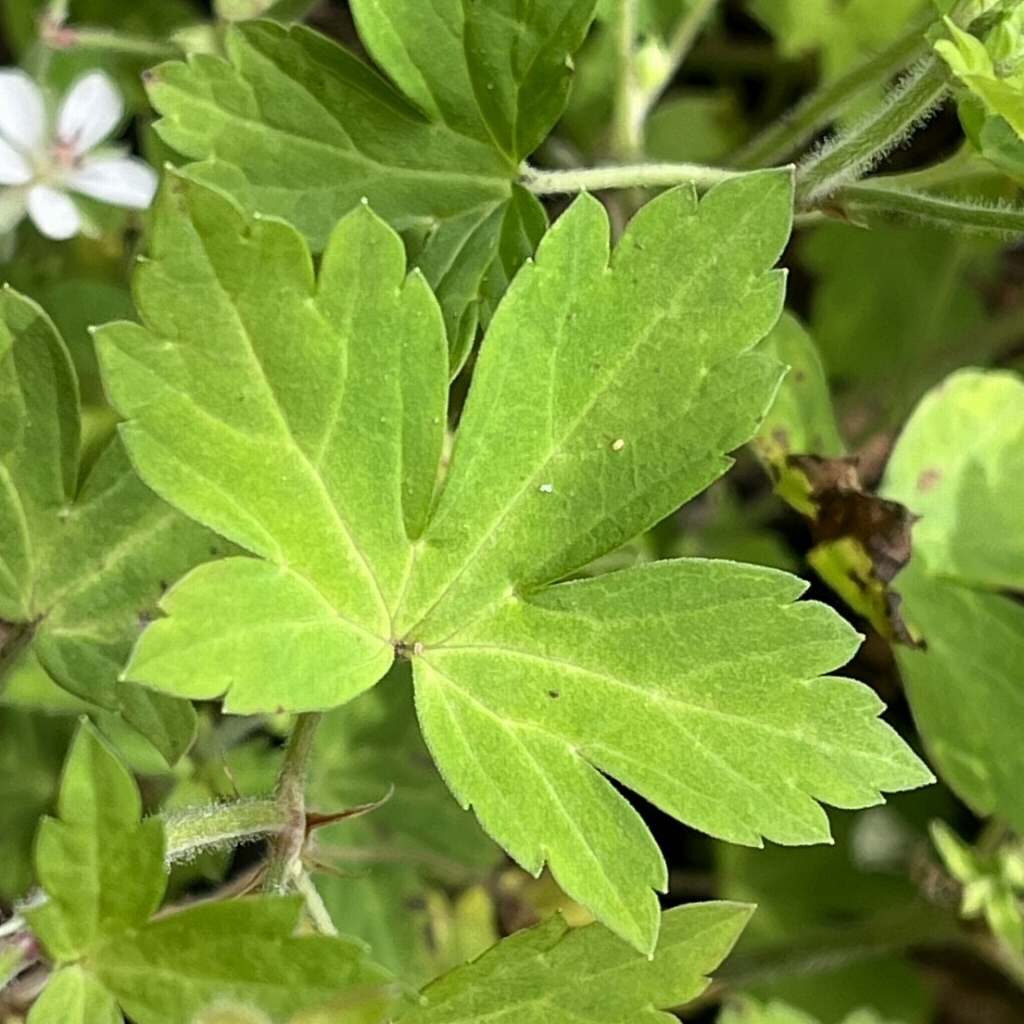ゲンノショウコは古くから伝わる下痢止めの妙薬。東日本では白色、西日本では淡い赤紫色、日本海側では鮮やかな赤紫色の花を咲かせます。
Geranium Herb is an antidiarrheal medicine that has been handed down since ancient times. The flowers are white in eastern Japan, pale reddish purple in western Japan, and vivid reddish purple in the Sea of Japan side.
【仮名】ゲンノショウコ, フウロソウ
【和名】現の証拠, 風露草
【英名】Geranium Herb, Dewdrop Cranesbill
【学名】Geranium thunbergii
【誕生】09/ 07, 09/ 18
【開花】07, 08, 09, 10月
【花色】White, Purple



ゲンノショウコ
ゲンノショウコの生態
ゲンノショウコはフウロソウ科の多年草です。日本では北海道から九州まで、国外では朝鮮半島から中国まで分布し、日当たりのよい山野や道端などで自生。ラテン語の種名ツンベルギは江戸時代の日本に滞在したスウェーデンの植物学者カール・ペーテル・ツンベルクへの献名です。
ゲンノショウコの名前
ゲンノショウコの和名の由来は、古くから下痢止めの妙薬とされ、煎じて飲むと実際その効果がすぐに現れるからです。そのため、各地で「痢病草」「赤痢草」「医者いらず」「医者泣かせ」「忽ち草」「薬の花」などの呼び名も。また、同科同属の総称で「風露草」とも呼ばれます。
ゲンノショウコの葉
ゲンノショウコの葉は対生し、3~5裂の掌状で葉縁に鋸歯が入り、手触りは柔らか。葉の形から「猫足」という別名があります。また、茎は地を這って分枝し、下向きの毛が密生。茎が蔓のように伸びながら広がり、花の形がウメに似ていることから「梅蔓」という別名もあります。
ゲンノショウコの花
ゲンノショウコの花は枝先の葉腋から細長い花柄を伸ばし、2輪ずつ咲きます。花弁が5枚、萼片が5枚。雄しべは花糸が10本で葯が青紫色、雌しべは花柱が5つに裂けて紅色です。花色は地域によって分かれ、東日本では白色、西日本では淡い赤紫色、日本海側では鮮やかな赤紫色。
ゲンノショウコの実
ゲンノショウコの実は蒴果。熟すと5枚の果皮が裂けて反り返り、5つの種子を散らします。それが鳥の嘴のように細長い形なので、ラテン語の属名ゲラニウムも「鶴」という意味。また、屋根に飾りが施されたお神輿のように見えるので「御輿草」や「風露草神輿草」と呼ばれます。
ゲンノショウコの利用
ゲンノショウコは古くから伝わる民間薬。有効成分はフィロバロールタンニン、没食子酸、クルセチオン、コハク酸などです。茎葉の陰干しを煎じて下痢、便秘、整腸に用いますが、飲み過ぎても副作用の恐れがない優れもの。野菜として油炒めや和え物、佃煮などでも食べられます。
Geranium Herb
Geranium Herb is a perennial plant of the Geraniaceae family. Distributed in Japan from Hokkaido to Kyushu, and overseas from the Korean Peninsula to China, it grows naturally in sunny mountains and fields and roadsides. The Latin species name thunbergii is a dedication to Carl Peter Thunberg, Swedish botanist who stayed in Japan during the Edo period.
The Japanese name of Geranium Herb is “evidence of reality”. It has been used as an anti-diarrheal medicine since ancient times, and its effect appears immediately when it is brewed and drunk. Therefore, in various places, it is also called “Diarrhea”, “Dysentery”, “No doctor needed”, “Doctor’s cry”, “In a short time”, “medicine flower”. In addition, it is also called “Wind and dew” as a Japanese generic name of the same family and genus.
The leaves of Geranium Herb are opposite, palmate with 3 to 5 lobes, and the leaf margins are serrated, and the touch is soft. It is also known as “Cat’s foot” because of the shape of the leaves. In addition, the stem crawls on the ground and branches, with dense downward hairs. It is also known as “Plum vine” because the stems grow and spread like vines, and the shape of the flower resembles a plum.
Flowers of Geranium Herb stretch out from the leaf axil at the tip of the branch and bloom in pairs. 5 petals and 5 sepals. The stamens have 10 filaments and the anthers are bluish-purple. The flower color varies depending on the region. White in eastern Japan, pale reddish purple in western Japan, and vivid reddish purple in the Sea of Japan side.
The fruit of Geranium Herb is a capsule. When ripe, the 5 pericarp splits and curls, scattering 5 seeds. Its slender shape resembles a bird’s beak, hence the Latin genus name geranium, which means “crane”. It is also called “Portable shrine” because it looks like a Japanese portable shrine with decorations on the roof in Japan.
Geranium Herb is a traditional folk medicine. Active ingredients include phyllovarol tannin, gallic acid, crucethion, and succinic acid. It is used for diarrhea, constipation, and intestinal regulation by decoction of dried stems and leaves. As a vegetable, it can be eaten as stir-fried in oil, dressed with vegetables, or boiled in soy sauce.


